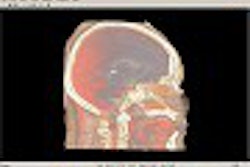A consensus conference involving some 25 specialists will be held in San Francisco this week to answer a major question in vascular imaging: What are the most appropriate criteria for diagnosing carotid disease with ultrasound?
Despite the popularity of ultrasound examinations of the carotid arteries, there is currently no consensus on diagnostic criteria.
"If you look at the literature on it, the thresholds that people have recommended for Doppler velocity values to diagnose a given degree of stenosis are all over the map," said Dr. Edward Grant, chairman of the radiology department at the University of Southern California’s Keck School of Medicine in Los Angeles.
The lingering confusion has implications for millions of patients at risk for cerebrovascular stroke -- many of whom are now referred for surgical intervention with ultrasound as their only preoperative imaging study.
"If your ultrasound is wrong, patients may be going to surgery unnecessarily or missing surgery that they actually need," said Grant, who will chair the October 22-23 meeting sponsored by the Society of Radiologists in Ultrasound (SRU) of Leesburg, VA. A final consensus statement will be announced at the SRU conference, also in San Francisco, on October 25.
However, the issue is more complex than a simple yes or no, given the many variables contributing to the discrepancy of opinions seen among what Grant describes as well-regarded vascular ultrasound laboratories. A major variable is the multiple different parameters used by different laboratories, whether peak systolic velocity, systolic ratio, diastolic velocity, or diastolic ratio.
"I think that hopefully we will come out with an idea or some recommendations as to which of the parameters are most effective," Grant said. "Whether we can actually come out with a set of given values that would apply to every specific lab is probably doubtful."
Discrepancies might also be due to technologists measuring velocities differently, or the alternative readings given by different brands of ultrasound equipment. Grant’s personal theory is that most of the discrepancies seen in the medical literature stem from the different statistical methods of evaluation chosen by the authors, which include peak accuracy, maximized sensitivity and specificity, or theoretical reductions in stroke risk.
Bolstering Grant’s theory is a study he led while working at the West Los Angeles VA Medical Center. "Using the same group of patients, with the same carotid arteries and the same angiographic correlation, we came out with relatively different Doppler parameters for the same degree of stenosis depending on which statistical method we used to arrive at the answer," he said.
The same study found that the vast majority of the patients seen could be diagnosed with confidence based solely on ultrasound alone. The remaining 15% of patients -- those with more than the 50% stenosis deemed as normal but less than the 300 cm/second peak systolic velocity used as the threshold for direct surgical referral -- underwent additional imaging with MR or CT angiography (American Journal of Roentgenology, April 1999, Vol. 172:4, pp. 1123-1129).
In all, the consensus conference will consider some 30 relevant journal articles published since 1989. There will also be presentations by experts including vascular surgeons Drs. Eugene Zierler, Gregory Moneta, and Denny Baker; Dr. Joseph Polak, the director of noninvasive vascular imaging at Brigham and Women’s Hospital in Boston; Dr. Alexei Alexandrov, assistant professor of neurology and radiology at the medical school of the University of Texas, Houston; and Sandra Katanick, executive director of the Intersocietal Commission for Accreditation of Vascular Laboratories in Columbia, MD.
In addition to the consensus conference report, the discussion of carotid diagnosis may lead to further research on the issue. The industry-supported SRU Research and Education Fund is now sponsoring research projects on ultrasound of post-menopausal bleeding, which was the subject of the first SRU consensus conference two years ago (Journal of Ultrasound in Medicine, October 2001, Vol. 20:10, pp.1025-1046).
By Tracie L. ThompsonAuntMinnie.com contributing writer
October 23, 2002
Related Reading
Quick ultrasound screening for AAA recommended in older men, September 27, 2002
New techniques increase ultrasound’s value in vascular imaging, July 8, 2002
B-flow ultrasound shows promise in carotid artery imaging, April 4, 2002
Copyright © 2002 AuntMinnie.com


















